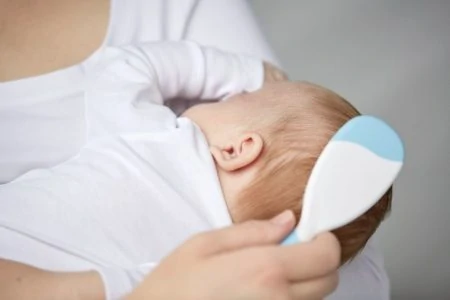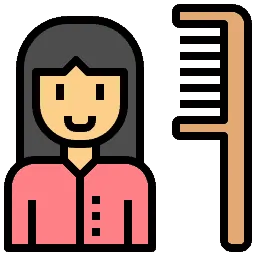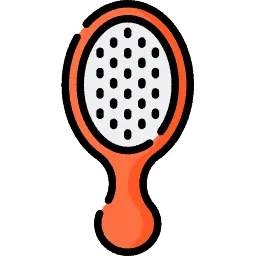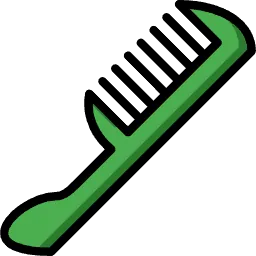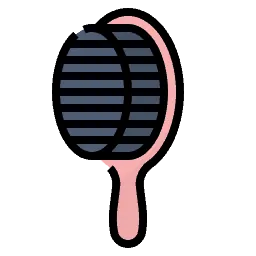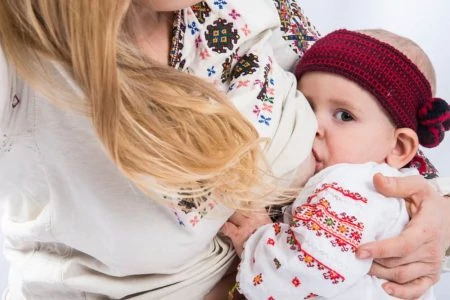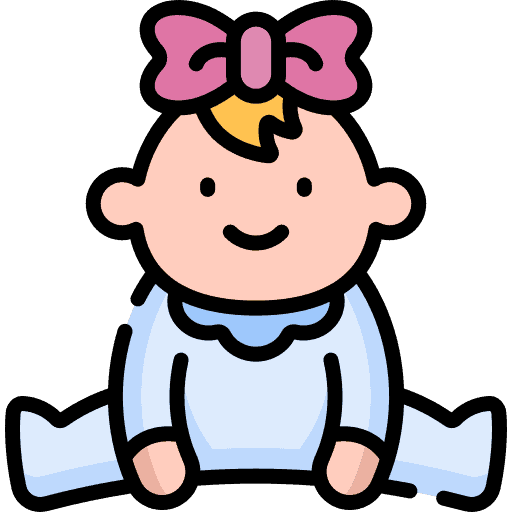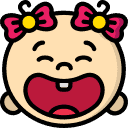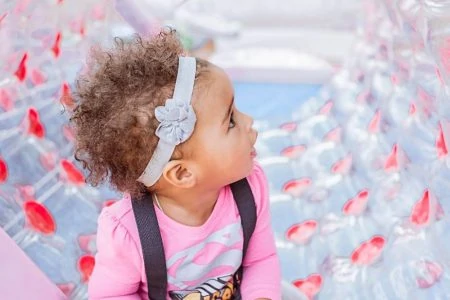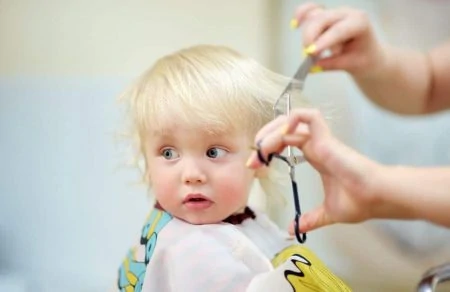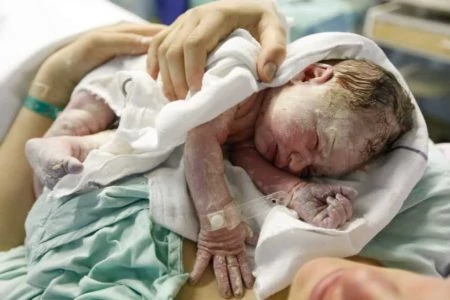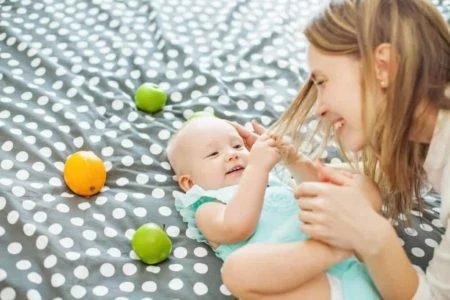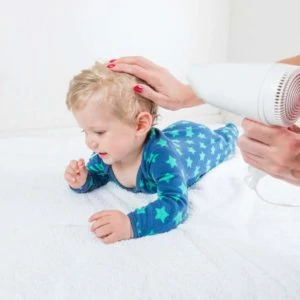You might think grabbing the first hair brush you see on the shelf is fine for your baby, but modern options offer much more than just detangling. Today, you can find specific brushes for styling fine hair, managing thick curls, or treating cradle cap.
Navigating the aisle can be confusing when you just want something safe for that soft, sensitive scalp. We spent hours researching and testing to break down the differences so you don’t have to guess.
To save you time, we reviewed the top-rated choices on the market. Whether you need a gentle grooming tool or a solution for flaky skin, here are the best baby hair brushes to keep your little one’s scalp healthy and happy.
- All-natural ingredients
- Helps with cradle cap
- Donates to charity with each purchase
- Easy to clean
- Big, ergonomic, and BPA-free
- Has both wide & fine teeth
Why Your Baby Needs a Hair Brush
There are several reasons to introduce a hair brush to your baby’s routine early on.
- Basic Grooming: Even if your baby only has a little peach fuzz, grooming keeps them looking tidy. Baby scalps are much more sensitive than yours, so a standard plastic brush is too harsh. A dedicated baby brush uses ultra-soft bristles to smooth hair without scratching gentle skin.
- Scalp Health: Brushing stimulates blood flow to the scalp. While this won’t magically make hair grow faster, it promotes a healthy environment for follicles. Regular brushing is also one of the most effective ways to prevent and treat cradle cap by loosening flaky skin (1).
- Relaxation and Bonding: Much like a scalp massage at the salon relaxes you, gentle brushing soothes your baby. It stimulates their neurological system and offers a perfect moment for quiet bonding after bath time.
Types of Baby Brushes
Most baby brushes fall into two distinct categories based on their primary function.
1. Soft-Bristled Brushes
These are designed for grooming and smoothing. They feature ultra-soft bristles made from natural goat hair or synthetic nylon. Because the bristles are so soft, they don’t “comb” through hair like an adult brush; instead, they lay the hair flat and distribute natural oils. These are ideal for newborns with fine hair or sensitive scalps.
2. Massaging or Cradle Cap Brushes
These brushes focus on scalp health rather than styling. They are usually made of silicone, rubber, or flexible plastic. The bristles are firmer, allowing you to massage the scalp and loosen cradle cap flakes during bath time. However, they aren’t great for detangling longer hair as the rubbery material can grip and pull strands.
Buying Guide
Before you buy, consider these specific features to find the right match for your baby’s needs:
Product Reviews
We tested various styles to see which ones offered the best grip, softness, and effectiveness. Here are our top picks.
DermFrida SkinSoother Hair Brush
Best for Cradle Cap
This multitasking bath tool is a game-changer for parents dealing with flaky scalps. Rather than just grooming hair, the DermaFrida is designed to keep the skin underneath healthy. It functions as a brush, a scalp exfoliator, and a washcloth alternative all in one.
We were impressed by how effectively it manages cradle cap and eczema. The silicone bristles are firm enough to loosen dry skin but soft enough to provide a relaxing massage that boosts circulation. It’s much more hygienic than a traditional baby washcloth because silicone doesn’t trap smells or bacteria.
Since it is made of 100% silicone, it dries instantly and resists mold. The ergonomic design slips right between your fingers, giving you excellent control even when the brush is soapy and wet.
You get two in a pack, so you can keep one in the diaper bag and one in the tub. It’s not a styling tool for long hair, but for scalp maintenance, it is unbeatable.
Pros
- Ergonomic grip prevents slipping in the bath.
- Includes two brushes per pack.
- Antibacterial silicone dries instantly.
Cons
- Not designed for detangling or styling.
- More expensive than standard plastic combs.
- Small size might be easy to misplace.
Our Ratings
Royal Infant Natural Wooden Baby Hair Brush
Best All Natural Brush
If you prefer natural materials over plastic, this Royal Infant brush is a lovely choice. The handle is crafted from smooth beech wood, and the bristles are made from genuine goat hair. It is incredibly soft, making it perfect for newborns with sensitive “soft spots.”
The natural fibers help distribute oils to condition the hair while increasing circulation. We found it gentle enough to use on a dry scalp without causing irritation.
However, natural bristles do have quirks. You might notice some shedding at first, which is standard for goat hair brushes. To reduce this, rub the brush briskly against your palm or a towel before the first use to knock loose any stragglers. Also, be aware that wet goat hair can have a distinct animal smell, so it is best used on dry hair.
A nice bonus: Royal Infant donates 5% of their sales to the Make-A-Wish Foundation, so your purchase supports a great cause.
Pros
- Natural beech wood and goat hair construction.
- Extremely soft on sensitive scalps.
- Purchase supports the Make-A-Wish Foundation.
Cons
- Bristles shed initially.
- Not suitable for use in water (wood may warp).
Our Ratings
Safety 1st Easy Grip Brush and Comb
Best Budget Baby Hair Brush
You don’t need to spend a fortune to get a reliable grooming set. This Safety 1st duo offers a brush and comb for less than the price of a fancy latte.
The brush features a chunky, rubberized handle that is easy for parents to hold and comfortable for toddlers learning to brush their own hair. The bristles are synthetic and slightly denser than natural hair brushes, which means they can actually tackle mild tangles as your baby grows.
The included comb is a standout feature. It has two sections: wide teeth for detangling and finer teeth for smoothing. We found the comb remained useful long after our babies outgrew the soft brush.
While it’s great for the price, the bristles can get bent if you toss it into a drawer under heavy items. Store it bristle-side up to keep it in good shape.
Pros
- Dual-density comb is versatile for toddlers.
- Chunky handles are easy to grip.
- Excellent value for money.
Cons
- Synthetic bristles may bend over time.
- Colors vary, so you might not get your first choice.
Our Ratings
FridaBaby Head-Hugging Brush and Comb Set
Best Brush & Comb Set
FridaBaby is known for smart design, and this “Head-Hugging” set is no exception. The unique selling point here is the flexible base that bends to contour perfectly to your baby’s round head.
The brush lacks a traditional handle. Instead, it has a strap that slips over your hand, allowing you to palm the brush. This gives you great control and prevents you from dropping it on a wiggly baby. The bristles are soft nylon, perfect for smoothing fine hair and distributing oils.
For tangles, the set includes a fine-toothed styling comb that snaps into the back of the brush base. This nesting design, combined with the included hard case, keeps everything clean and compact. It is perfect for tossing into a diaper bag without worrying about lint or crumbs getting into the bristles.
Cleaning is easy, just wipe with rubbing alcohol. However, ensure it is completely dry before snapping it back into the case, as there are no ventilation holes.
Pros
- Flexible base molds to baby’s head shape.
- Items snap together into a protective travel case.
- Palm-grip design offers superior control.
Cons
- Case lacks drain holes; must dry fully before storing.
- Price point is higher than basic sets.
Our Ratings
Disney Minnie Baby Hair Brush & Comb Set
Cutest Baby Brush
If you want to make grooming fun, this Minnie Mouse set is a winner. The bright colors and character design can serve as a great distraction for squirmy babies who hate sitting still.
The bristles are ultra-soft, making it safe for delicate scalps, though they are too soft to act as a scrubber for cradle cap. The matching comb features both fine and wide teeth, giving you options for different hair textures or removing small tangles.
The handle is thick and durable, which is great because this brush often doubles as a toy. As your child grows, they can use it to brush their own hair or their dolls’ hair without risk of injury. It’s easy to wash with soap and water, keeping it hygienic for daily use.
Pros
- Fun design appeals to toddlers.
- Safe to use as a toy for older kids.
- Versatile comb with wide and fine teeth.
Cons
- Bacteria can trap where bristles meet the base.
- Handle shape can be awkward for larger adult hands.
- Bristles are too soft for exfoliation.
Our Ratings
When to Start Brushing Baby Hair
You can start brushing immediately after birth. Many parents hesitate because of the fontanels (soft spots), but these areas are covered by a tough membrane and are stronger than they look (2). Using a soft-bristled brush is perfectly safe and won’t harm your newborn.
Even if your baby is bald, brushing during bath time stimulates the scalp and helps prevent cradle cap.
Keep in mind that newborn hair is often temporary. Hormonal changes cause many babies to lose their hair within the first few months, or they might rub a bald spot on the back of their head from sleeping. When the new hair comes in, don’t be surprised if the texture or color is completely different.
How to Brush Your Baby’s Hair
The technique depends on your goal: simple grooming or treating a flaky scalp.
FAQs
The Bottom Line
For most parents, the FridaBaby DermFrida SkinSoother is the top choice. It’s affordable, hygienic, and tackles the most common scalp issue babies face, cradle cap. Since it’s made of silicone, you never have to worry about mold or bacteria buildup. Plus, it doubles as a washcloth, saving you money and laundry.
